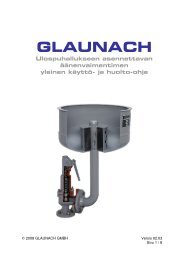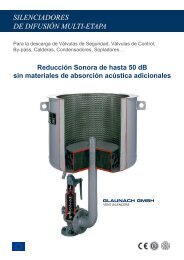1. acoustic dimensioning - GLAUNACH Vent Silencers
1. acoustic dimensioning - GLAUNACH Vent Silencers
1. acoustic dimensioning - GLAUNACH Vent Silencers
Create successful ePaper yourself
Turn your PDF publications into a flip-book with our unique Google optimized e-Paper software.
<strong>1.</strong>4 SOUND POWER LEVEL OF VALVES<br />
THE SILENCER HANDBOOK<br />
Part IV | page 7 of 14<br />
Valves are a primary source of noise in flow systems. A part of this <strong>acoustic</strong><br />
energy is transmitted through the valve body, often necessitating an <strong>acoustic</strong><br />
insulation of the valve itself; the greater part is dissipated through the flowing<br />
medium, requiring exhaust silencers.<br />
The following two calculation models can be used for a rough estimation of the<br />
sound levels produced by a valve without a silencer:<br />
Valve Noise Estimation acc. to VDI 2713<br />
L W0 = 17×log(M) + 50×log(T0) – 15 [dB]<br />
LW0: sound power levels emitted by the valve [dB]<br />
M: mass flow capacity [t/h]<br />
NOTE: use M = 10 t/h for values < 10 t/h<br />
T0: Gas temperature at the valve [K]<br />
This formula calculates the overall sound power, i.e. the <strong>acoustic</strong> energy<br />
generated by the valve. This is an absolute value, which is not affected by<br />
environment or distance.<br />
Valve Noise Estimation acc. to ANSI/API RP 521<br />
Lp30m = L + 10×log(0.5×M×C²) [dB]<br />
Lp30m: Sound Pressure Level at 30 m (100 ft) from stack tip [dB]<br />
L: internal sound power level [dB]<br />
M: mass flow capacity [kg/s]<br />
C: speed of sound in the gas at the valve [m/s]<br />
This formula calculates the sound pressure levels for an assumed monitoring<br />
point 30 m (100 ft) from the valve orifice. This value, while directly related to the<br />
actual noise impression and the values measured with a sound meter, can in<br />
practice be affected by the surroundings.<br />
COMMENT<br />
These calculations regard only the octave bands from 500<br />
to 8,000 Hz; the resulting A-weighted levels are close to the<br />
unweighted dB(Lin) levels, and somewhat higher than the<br />
corresponding measured dB(A) values<br />
→ Both approximations yield values on the safe side.<br />
© <strong>GLAUNACH</strong> GMBH Edition 2010








